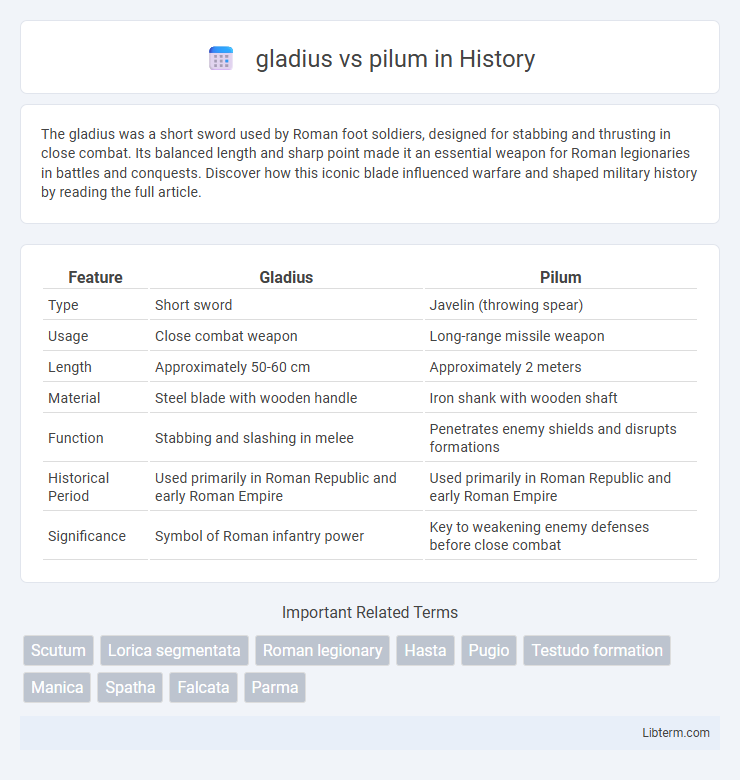The gladius was a short sword used by Roman foot soldiers, designed for stabbing and thrusting in close combat. Its balanced length and sharp point made it an essential weapon for Roman legionaries in battles and conquests. Discover how this iconic blade influenced warfare and shaped military history by reading the full article.
Table of Comparison
| Feature | Gladius | Pilum |
|---|---|---|
| Type | Short sword | Javelin (throwing spear) |
| Usage | Close combat weapon | Long-range missile weapon |
| Length | Approximately 50-60 cm | Approximately 2 meters |
| Material | Steel blade with wooden handle | Iron shank with wooden shaft |
| Function | Stabbing and slashing in melee | Penetrates enemy shields and disrupts formations |
| Historical Period | Used primarily in Roman Republic and early Roman Empire | Used primarily in Roman Republic and early Roman Empire |
| Significance | Symbol of Roman infantry power | Key to weakening enemy defenses before close combat |
Introduction to Roman Military Weapons
The gladius, a short sword approximately 18-24 inches in length, was essential for close combat and thrusting in the Roman legion. The pilum, a heavy javelin measuring around 6-7 feet, was designed to disrupt enemy formations by piercing shields and armor before hand-to-hand fighting began. Together, these weapons formed a complementary system that contributed to the effectiveness of Roman military tactics.
Historical Origins: Gladius and Pilum
The gladius, a short sword used by Roman legionaries, originated from Celtiberian designs during the Roman Republic era, prized for its thrusting and slashing capabilities in close combat. The pilum, a heavy javelin developed around the 4th century BCE, was engineered for both throwing and penetration, designed to disable enemy shields before close-quarters fighting. Both weapons reflect Roman military innovation, combining versatility and lethality to dominate battlefield tactics in ancient warfare.
Design and Construction Differences
The gladius featured a short, double-edged blade approximately 18-24 inches long, designed for thrusting and close combat, with a sturdy wooden handle and a metal pommel for balance. In contrast, the pilum was a heavy javelin around 6-7 feet in length, constructed with a long iron shank and a pyramidal head designed to bend upon impact, preventing enemies from throwing it back. The distinct design purposes--gladius for melee fighting and pilum for ranged throwing--highlight their complementary roles in Roman military tactics.
Tactical Roles on the Battlefield
The gladius excelled in close-quarters combat, allowing Roman infantry to engage enemies with quick, lethal stabbing motions during tight formations like the testudo. The pilum was strategically designed as a heavy javelin to disrupt enemy lines, penetrate shields, and reduce their defensive capabilities before melee combat. Together, these weapons maximized Roman legion efficiency by combining ranged disruption with devastating hand-to-hand effectiveness.
Effectiveness in Close Combat
The gladius, a short Roman sword with a double-edged blade of approximately 18-24 inches, excels in close combat due to its design for stabbing and slashing within tight formations. The pilum, a heavy javelin averaging 2 meters in length, serves primarily as a throwing weapon to disrupt enemy ranks before melee engagement but is less effective in hand-to-hand fighting once thrown. In close quarters, the gladius's maneuverability and lethal thrusting capability outperform the pilum, which lacks versatility beyond its initial projectile use.
Throwing Power: Pilum vs. Gladius
The pilum, designed as a heavy javelin, possessed greater throwing power and range compared to the gladius, allowing Roman soldiers to disrupt enemy formations before close combat. Its flexible iron shank ensured the pilum stuck in shields and bent upon impact, rendering the enemy's defense cumbersome. The gladius, primarily a short stabbing sword, was not intended for throwing and lacked the kinetic energy and aerodynamic design integral to the pilum's effectiveness in ranged attacks.
Training and Usage by Roman Soldiers
Roman soldiers trained rigorously with the gladius to master close-quarters combat, emphasizing quick, powerful thrusts ideal for infantry battles. The pilum, a heavy javelin, required repetitive practice to develop accuracy and strength for effective long-range throwing, disrupting enemy formations before hand-to-hand fighting. Both weapons were integral to Roman military tactics, with the pilum softening enemy lines and the gladius capitalizing on the chaos in close combat.
Adaptations and Variations Over Time
The gladius evolved from a short stabbing sword to designs featuring broader blades for improved cutting and thrusting efficiency, adapting to changing combat styles and diverse enemy armor. The pilum saw variations such as reinforced iron shanks and adjustable weights to enhance penetration and reduce enemy weapon reuse, reflecting tactical shifts in Roman legion formations. Both weapons exhibit modifications driven by battlefield experience and technological advancements across the Roman Republic and Empire periods.
Influence on Later Military Arsenal
The gladius and pilum significantly influenced the development of later military arsenals by setting standards for close combat and ranged weaponry. The gladius inspired the design of short, effective swords used for stabbing and slashing in tight formations, while the pilum contributed to the evolution of tactical javelins that could disrupt enemy formations with penetrating power and flexibility. These Roman innovations shaped medieval and early modern weapon development, emphasizing versatility and strategic battlefield roles.
Legacy and Cultural Impact
The gladius and pilum symbolize the disciplined might and tactical innovation of Roman legions, shaping military traditions across centuries. The gladius, a short sword, became emblematic of Roman infantry, influencing sword design throughout medieval Europe. The pilum, a uniquely engineered throwing spear, revolutionized battlefield strategies and inspired the development of ranged infantry weapons in later armies.
gladius Infographic

 libterm.com
libterm.com